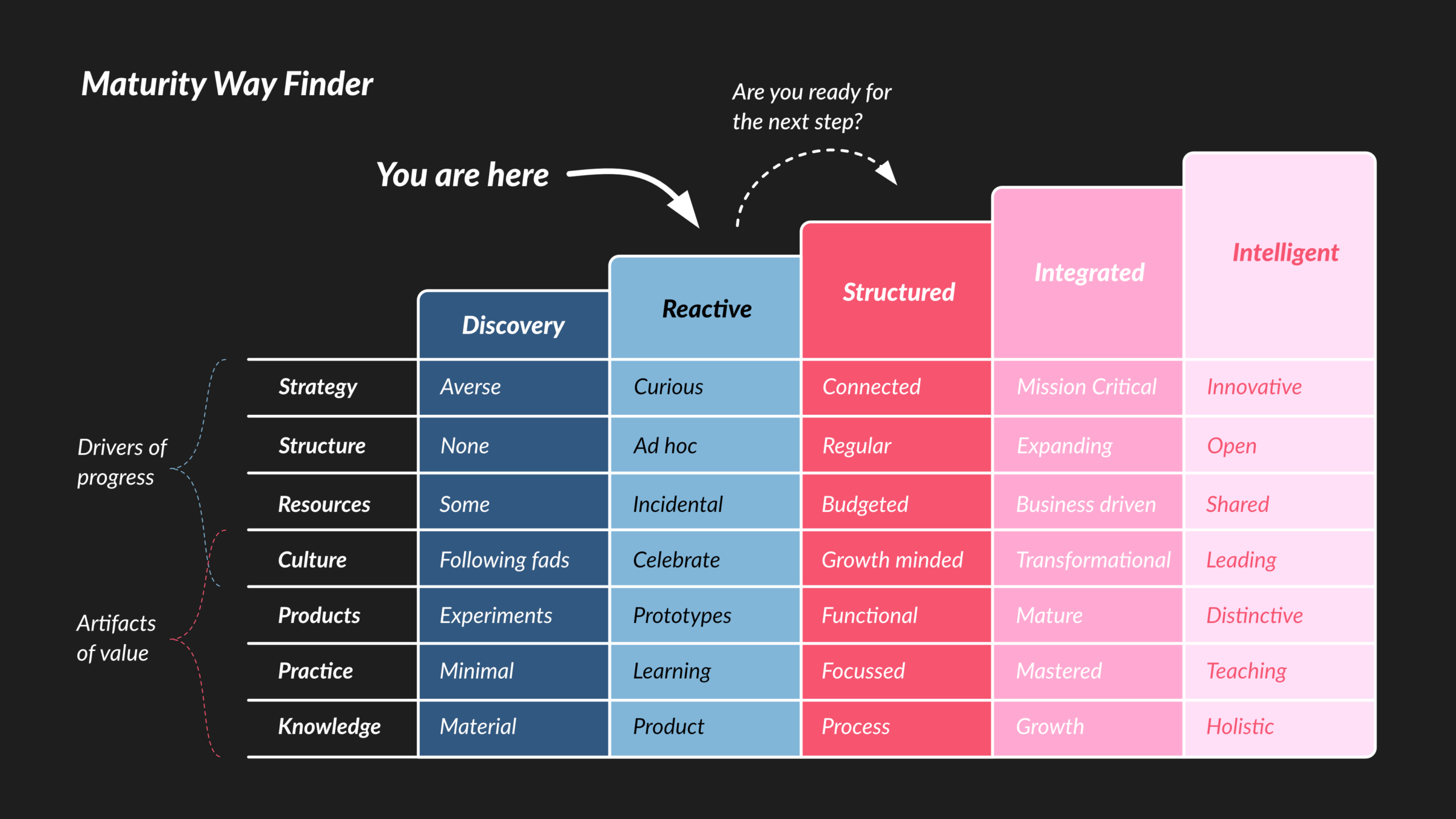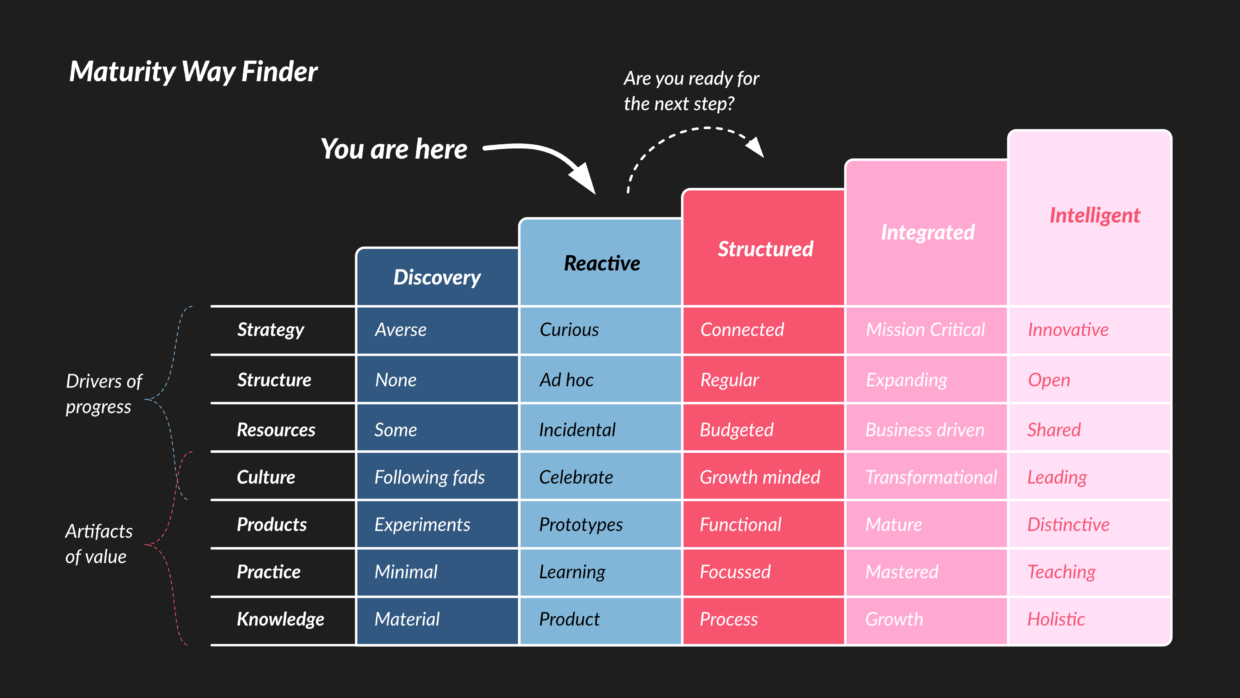Improving the Customer Experience your organization provides takes time, but can we make our own journey a bit smarter? I think we can. It takes a quick scan to plot yourself, your team, your products and services on the ‘maturity map’, followed by a list of recommended improvements, learning tracks, internal and external stakeholder engagement and some business sensibility. As with every journey: knowing where you are is half the battle, so let’s get started!
We’re focusing on two main indicators of ‘where you are’ in the Customer Experience (CX) part of your business: drivers of improvement and artifacts of growth. In a nutshell ‘drivers’ of improvement are all the enablers and circumstances in your organization that help you grow the best team, results, stakeholders and products. The latter are the list of ‘artifacts of value’, the things that we can point out and tell us how capable we have been in the meantime. Think of behaviors, perspectives, but also quality of the products and how their architecture integrates with your organization.
Please note: as this article describes the maturity for design and CX, these principles apply to any form of progress: innovation, branding, technology, independency and business alike.
Note
The maturity way finder
Although people will claim that the complex world cannot be captured in a simple model, there is merit in using a simplified model. In this case it helps you look at recognizable behaviors and artifacts, but also helps you see how you need to catch up some aspects of your CX journey, so you can progress.

Five Levels of Maturity
In the horizontal axes we identify the five levels of maturity. This amount of levels is finely grained enough for us to work with. The moment you need more levels, you probably don’t need the model anymore. The reason of these levels is that experience and data have show us that at a certain ‘level’ we show specific behaviors, focus on specif things and see the world in a specific way. Similarly, we experience new challenges at each level.
The levels we choose are named to how you use CX within your organization, from inspirational plaything, to part of the backbone of your products and services, and beyond:
- Discovery: is a phase where personal interest and curiosity play are big role. You want to discover if this CX thing can be of value to invest your time in. The intrinsic impulses of the individual employee are stronger drivers as well as some leeway to follow them.
- Reactive: you have shown that CX might be of value, so now you’re dependent of colleagues to focus your efforts on real world challenges. This can lead to a flying wheel effect. More and more people will ask for your insights, help. The focus is on CX in new areas.
- Structured: at management level the value of CX has been recognized and you are asked to broaden the scope and integrate CX into more and more parts of the organization. This needs structure, professional skills and resources from the entire organization.
- Integrated: CX is a driver for the way the organization looks at the world and the products and services reflect this. Skill levels grow to master level. The company changes to optimize the yield of CX.
- Intelligent: CX and its influence are beyond the scope of the organization. Partners, customers and possibly more stakeholders will benefit of the scope of the CX transformation. The organization will be perceived as a leader in its field and behave as a connector and will create open initiatives to accelerate change in the industry.
Customer eXperience and User eXperience
I quickly stepped over the definition of Customer Experience (CX) and why I’m not talking about UX (User Experience), so here’s a brief insight into why. Customer Experience is a broader scope and perspective on what people experience when they are dealing with a company. UX is a very important part of CX. It’s how (digital) products and services behave towards people.
The journey of a customer is broader though and I think that journey, or even their ‘Job to be done’ is the best way to shape UX, brand, communication, operation, service, marketing and value to the customer. In short: CX creates a great vantage point to enable your organization to grow better products and services. Following CX you might venture into system and enterprise design to actually shape the change in and around the organization.

Drivers of progress
The top four aspects of maturity are the main drivers that show and help your progression of CX. They probably seem arbitrary, but will help any team, or individual to gain recognition and leverage to get things done on your journey. These are in no particular order:
- Strategy: strategy says something about how important CX is to leadership and trajectory of the company. Both need to be formalized in general, to more and more specific terms. The strategy of an organization will determine both the perceived value, or yield, but also the possible investments to help CX grow.
- Structure creates the means to scale incrementally, make things predictable and useful in more than just the enthusiasts mind. Structure creates clarity and commitment to form teams, set processes, ways of working, collaborate within the organization and create valuable outcomes.
- Resources are: team members, budget, space, time, attention and commitment through out the company. Most growing CX teams focus on resources like money and people, but should be aware of the need to connect with the other parts of the organization.
- Culture might sound vague as a driver but should be payed attention to in each and every step. Are people empowered to make, show and join. Do they celebrate success, propagate energy and openness. Are they prone to embrace failure, learn and share knowledge?
Artifact of value
When an organization commits to growth, they tend to gain all kinds of artifacts of change and value. These are the milestones and persistence of your progression, in short: value that you can build upon. Here are in no particular order the four artifacts of value that anyone can recognize in their journey of CX:
- Culture overlaps the drivers of progress and artifacts of value because it’s hard to build up. Its reach, measures to grow and maintain continuity and perceived ease and self evidences are also great stepping stones that build up though time.
- Products seem to be the bottom line of CX for most. The completeness, importance, integration, quality and depth of CX in the products determine your build up value. The more your CX philosophy are embedded in the products and services you provide, the easier it gets to improve speed, quality and scalability.
- Practice are the amount of iterations you have done to get where you are right now. In the case of each phase of maturity: how many hours, iterations you, your team, your organization, your partners have spend on the topic CX. Practice is sincere and crucial for maturity. It cannot be faked.
- Knowledge and experience go hand in hand. Creating, keeping and internalizing knowledge in various levels of your teams, leadership, customers will become more and more professional.
Fill in the blanks! Disclaimer.
This exploration of CX maturity is of course quite high level. To get a real sense we need to get into the details. Specifically in these fields you can expect more details:
- Strategy: talks in terms of how for example CX is applied to create appealing, valuable and feasible products and services. The goal is a organization wide shared, plainly spoken understanding of what the CX value is and should be.
- Structure: each phase will ask for specific structure for the teams and the organization to collaborate. Think of working agile, using similar vocabulary, creating awareness in various phases of maturity.
- Knowledge: Although the act of learning and practice is more important than specific knowledge, in CX there are quite a lot baseline themes an organization should practice. For example:
- Doing research with people
- Creative processes like Design Thinking
- Coping with biases
- Create for inclusivity
- Designing for contrast
- Copy writing
- Brand design
- Product: Growing as a team to create better and better products will create the need to follow the de-facto design, production and integration standards. This will become more and more important throughout the lifetime of the CX team.
Some of these aspects don’t have a definitive answer, because this is done and thought about differently, depending on your goals and situation. Your current situation, pitfalls and gripes and the way you come about your vision and path to follow is very indicative on which phase you are.
To find out, most design coaching/ director agencies will ask you to fill in a broad survey, followed by a specific assessment. This will create a map of your strengths as well as steps to be taken to get to the next phase.
